|
|
 |
|
 |
| |
Publisher: Chairman Jian-Jang Huang Editors: Professor
Snow H. Tseng, Ms. Hsiao-wen Lin September 30, 2019 |
| |
|
 |
|
Congratulations to To-Fan Pan, a GIPO Master student, for winning the Student Award in the Laser Display and Lighting Conference 2019, under the instruction of
Professor Lung-Han Peng.
His winning thesis is “Generation of multi-wavelength yellow-orange lasers using
chi(2) chirped nonlinear photonic crystals,” which is a team work involving professors and students of National Taiwan University, University Paris 13, Tohoku University, Japan, and Leibniz-Institute für Höchstfrequenztechnik, Germany.
The “High Speed Silicon Photonics Devices & Transmission Technologies Conference,” hosted by GIPO
Professor Gong-Ru Lin, held on May 10, 2019, at Barry Lam
Hall, has hereby been completed successfully.
For more information, please refer to the following website:
https://www.mem.com.tw/arti.php?sn=1905100001
Congratulations to GIPO
Professor Gong-Ru Lin for having the honor to be appointed as The Seventeenth Y. Z. Hsu Science Chair Professor (Optoelectronics Science & Technology).
Congratulations to GIPO
Professor Yuh-Renn Wu, a member of EECS badminton team, for winning 2nd place in the “2019 Faculty & Staff Badminton Tournament of College of Engineering, College of EECS, College of Law & College of Science, NTU”.
Congratulations to GIPO professors Chung-Chih Wu, Hoang-Yan Lin and Guo-Dung Su, their Industry-Academy Co-research thesis with Applied Materials, Inc. has won the
"SID Display Week 2019 Distinguished Paper
Award"!
Their winning thesis is “3D pixel configuration for ultimate optical out-coupling of OLED displays.” The Society of Information Display, SID, display week 2019, held in San Jose, USA, is the largest international conference and exhibition of displays, which has attracted almost ten thousand attendants every year. Many electronics companies and academic organizations around the world have keenly taken part in this event.
Congratulations to GIPO
Professor Chi-Kuang Sun for winning the
"NTU 2018 Excellent Teacher – English-Taught Courses Award."
|
|
 |
|
 |
|
| |
|
 |
|
April “GIPO Colloquium” Highlights
(Compiled by Li-Chi Yao) |
|
|
2:20 pm, April 12 (Fri.), 2019 |
|
Speaker: |
Professor Meng-Lin Li, Department of Electrical Engineering, National Tsing Hua University |
|
Topic: |
Development of Large Field of View, High Speed, High SNR, and High Axial Resolution Optical Resolution Photoacoustic Microscopy |
|
|
GIPO has invited
Professor Meng-Lin Li to deliver a speech concerning “Development of Large Field of View, High Speed, High SNR, and High Axial Resolution Optical Resolution Photoacoustic Microscopy” at 105 lecture theater, EE Bldg. no.2., on April 12, Friday.
Professor Li has performed outstandingly in the academic circle. His speech was marvelous, rich in content, and the professor interacted well with students. GIPO professors and students participated in the event with enthusiasm and learned a lot. |
| |
|
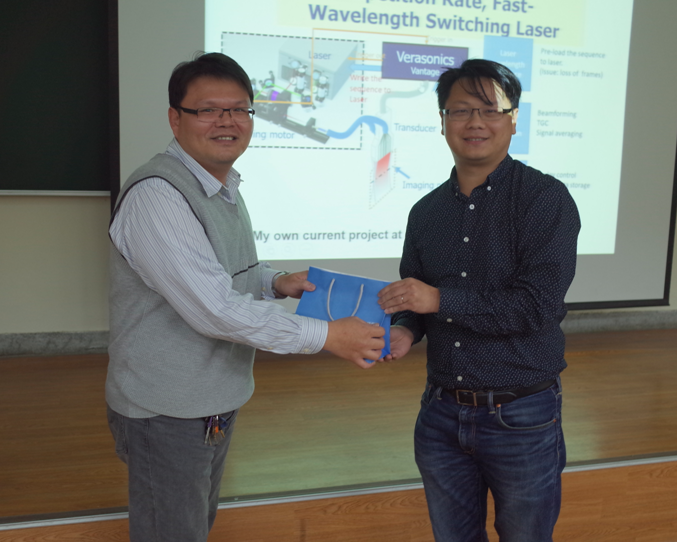 |
|
Professor Meng-Lin Li (left), and GIPO
Professor Hsiang-Chieh Lee
(right) |
|
|
|
1:30 pm, April 19 (Fri.), 2019 |
|
Speaker: |
Professor Silvano Donati, University of Pavia |
|
Topic:
|
Self-Mixing Interferometry: a Universal Yardstick to Measure Almost Everything |
|
|
GIPO has invited
Professor Silvano Donati to deliver a speech concerning “Self-Mixing Interferometry:
a Universal Yardstick to Measure
Almost Everything” at 105 lecture
theater, EE Bldg. no.2., on April
19, Friday. Professor Silvano Donati has been living in Taiwan over a long period of time. His speech was wonderful, rich in content and interacted nicely with students. GIPO
professors and students have enthusiastically taken part in this event and gained much from it. |
|
|
|
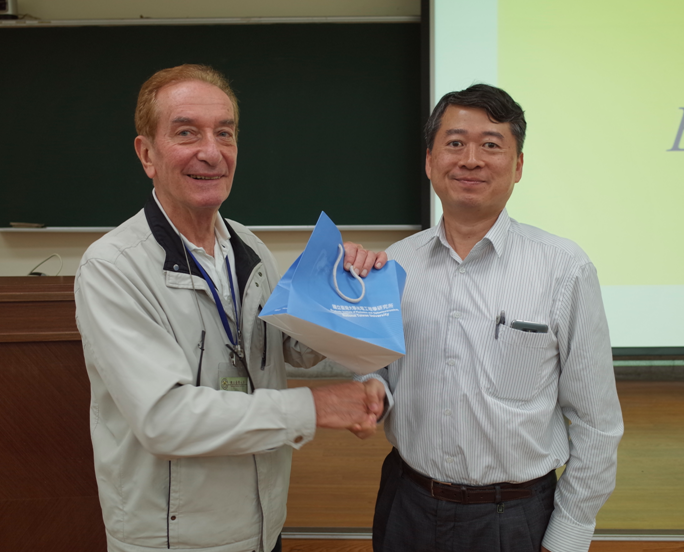 |
|
Professor Silvano Donati (left), and GIPO
Professor Sheng-Lung
Huang (right) |
|
|
May “GIPO Colloquium” Highlights
(Compiled by Li-Chi Yao) |
|
|
2:20 pm, May 3 (Fri.), 2019 |
|
Speaker: |
Professor Wen-Chuan Kuo, Institute of Biophotonics, National Yang Ming University |
|
Topic: |
Functional optical coherence tomography |
|
|
GIPO has invited Professor Wen-Chuan Kuo to deliver a speech concerning “Functional optical coherence tomography” at 105 lecture theater, EE Bldg. no.2., on May 3, Friday. Her speech
was fascinating, rich in content, and the professor interacted very well with students. GIPO professors and students participated with enthusiasm, and gained a lot from the event. |
| |
|
 |
|
Professor Wen-Chuan Kuo (left), and GIPO
Professor Hsiang-Chieh Lee (right) |
|
|
|
2:20 pm, May 10 (Fri.), 2019 |
|
Speaker: |
Professor Hui-Hsin Hsiao, Graduate Institute of Electro-Optical Engineering, National Taiwan Normal University |
|
Topic: |
The beauty of nano technology – from surface plasmon to metasurface |
|
|
GIPO has invited Professor Hui-Hsin Hsiao to deliver a speech concerning “The beauty of nano technology – from surface plasmon to metasurface” at 105 lecture theater, EE Bldg. no.2., on May
10, Friday. Professor Hsiao is a GIPO alumnus and has been doing excellently in academic circle. Her speech was marvelous, rich in content and interacted nicely with students. GIPO professors and students have enthusiastically participated in this event and gained a lot from it. |
| |
|
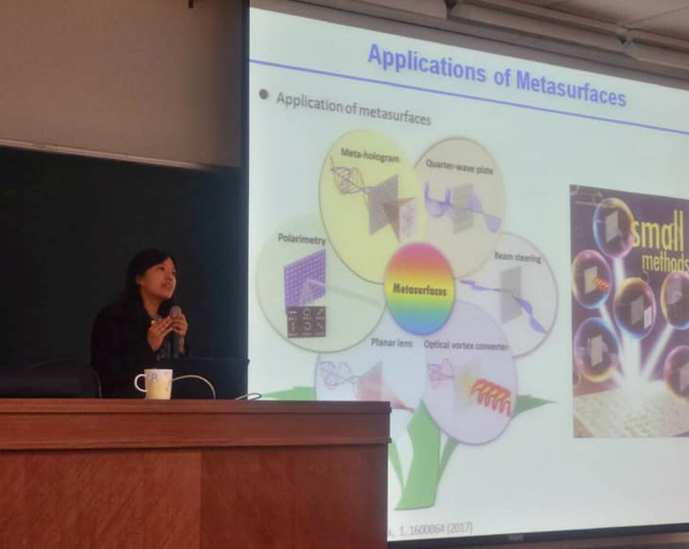 |
|
Professor Hui-Hsin Hsiao – the speaker of this speech |
|
|
Time: |
2:20 pm, May 17 (Fri.), 2019 |
|
Speaker: |
Professor Chun-Ta Wang, Department of Photonics, National Sun Yat-sen University |
|
Topic:
|
Adjustable liquid crystal, silicon, photonic elements |
|
|
GIPO has invited Professor Chun-Ta Wang to deliver a speech concerning “Adjustable liquid crystal, silicon, photonic elements” at 105 lecture theater, EE Bldg. no.2., on May 17, Friday. His speech
was excellent, rich in content and interacted nicely with students. GIPO professors and students have fervently participated in this event and benefitted a lot from it. |
|
|
|
 |
|
Professor Chun-Ta Wang (right), and GIPO Professor Jian-Jang Huang (left) |
|
|
Time: |
2:20 pm, May 24 (Fri.), 2019 |
|
Speaker: |
Professor Yu-Jung Lu, Research Center for Applied Science, Academia Sinica |
|
Topic:
|
Controlling light-matter interactions at nanoscale with plasmonics: from spontaneous emission to lasing |
|
|
GIPO has invited Professor Yu-Jung Lu to deliver a speech concerning “Controlling light-matter interactions at nanoscale with plasmonics: from spontaneous emission to lasing” at 105 lecture theater, EE Bldg. no.2., on May 24, Friday. Her speech was marvelous, rich in content and interacted very well with students. GIPO professors and students attended the event with enthusiasm and learned much from it. |
|
|
|
 |
|
Professor Yu-Jung Lu (right), and GIPO
Professor Hsiang-Chieh Lee (left) |
|
|
 |
|
 |
|
| |
|
 |
Enhancing performance of CH3NH3PbI3 perovskite solar cell with low-pressure control via Sandwich Evaporation Technique
Professor Ching-Fuh Lin
Graduate Institute of Photonics and
Optoelectronics, National Taiwan University
A sandwich evaporation technology (SET) process was established to modify vapor assisted solution process. The MAI dissolved in DMF was coated as a seed layer. Then PbI2-MAI was evaporated at the condition of thermal evaporation and SET machine, respectively. The concept of MAI-PbI2-MAI is originated from double mutual diffusion. It significantly promoted the crystallization of perovskite films. In order to further improve the quality, the low-vacuum controlling was applied to SET process to slow down the reaction rate. In this way, we have produced perovskite solar cells with efficiency up to 16%. This is of great significance to the industrial production of perovskite solar cells.
Under low-vacuum condition, the unreacted perovskite in the evaporation process can continue to finish completely, and the sandwich structure in MAI-PBI2-MAI further promoted the full progress of the reaction. Finally, the highly quality perovskite solar cells were formed. Fig.2. shows that the fully reflected perovskite solar cell exhibits superior performance. The photoelectric conversion efficiency can reach 16%.
|

|
|
Fig.1 The schematic structure of the device |
|
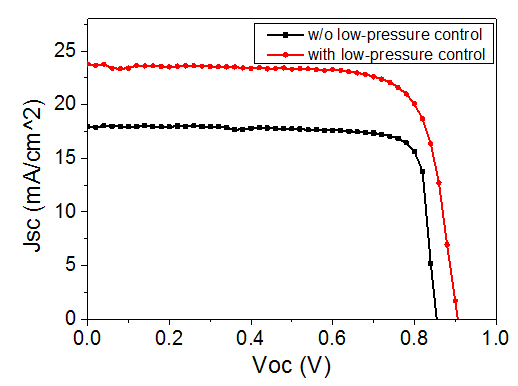
|
|
Fig.2 J-V curve of with and w/o low-pressure control for perovskite solar cells |
Generation of multi-wavelength yellow-orange lasers using chi(2) chirped nonlinear photonic crystals
Professor Lung-Han Peng
Graduate Institute of Photonics and
Optoelectronics, National Taiwan University
Strong optical absorption in the yellow spectral range due to chromophore in Melanin, Hemoglobin (Hb) and Oxyhemoglobin (HbO2) make clinic benefits by using yellow lasers for medical treatment to ophthalmology and dermatology. Interest has been invoked on yellow lasers as a depletion beam in a STED microscopy to achieve super-resolution bio-images when incorporated with green-yellow fluorescent beads.
Yellow lasers can be achieved via diode pump rare-earth doped crystals such as Dy:YAG (emission wavelength 580nm). However, this approach typically operates the laser crystal with a slope efficiency 10-15%. In comparison, yellow lasers can also be prepared via a nonlinear optical process. It combines an NIR pump laser with a second harmonic generation (SHG) crystal to facilitate the frequency doubling provided the laws of momentum and energy conservation can be maintained. Therefore the SHG efficiency would hinge up the NIR beam intensity, the chi(2) nonlinearity of the SHG crystal and the acceptance bandwidth (angle, temperature, wavelength) of the crystal.
In order to engage an efficient scheme of nonlinear green to yellow wavelength conversion, we reported an intra-cavity operation of cascaded optical parametric oscillation-sum frequency generation (OPO-SFG) monolithic chi(2) nonlinear photonic crystal (NPC). The chi(2) NPC was prepared by incorporating three 15mm-long quasi-phase-matching (QPM-OPO) structures with periodicity of 7.67, 7.68, 7.69
µm in parallel followed by a 5mm-long chirped QPM-SFG section with periodicity varied from 9.85 to 10.34
µm on periodically poled lithium tantalate (PPLT). Such intra-cavity operation of cascaded OPO-SFG nonlinear optics processes enables yellow-orange wavelength conversion from a green 532nm pump laser. A single-side slope efficiency > 17.8% can be easily achieved when placed inside a confocal laser cavity. This work was collaborated with
Prof. Azzedine BOUDRIOUA’s group (U. Paris 13, France), Prof. Hiroyuki YOKOYAM’s group (Tohoku Univ., Japan), and Dr. Katrin PASCHKE’s group (Ferdinand Braun Inst. Germany), and received outstanding achievement award from Laser Display and Lighting Conference 2019. The technical abstract can be found in the following website.
https://www.spiedigitallibrary.org/conference-proceedings-of-spie/11145/2540345/8th-Laser-Display-and-Lighting-Conference-Abstract-Book/10.1117/12.2540345.full?SSO=1
|
|
Corneal Tomograms Using Sub-micron Resolution Optical Coherence Tomography
Professor Sheng-Lung Huang
Graduate Institute of Photonics and
Optoelectronics, National Taiwan University
Accurate diagnosis of corneal pathology and morphological identification of different corneal layers require clear delineation of corneal three-dimensional structures and en face or cross-sectional imaging of palisade of Vogt (POV), neovascularization (NV) or corneal nerves. Here we report a prototype of full-field optical coherence tomography (FF-OCT) system with isotropic sub-micron spatial resolution in the en face and cross-sectional views. It can also provide three-dimensional reconstructed images and a large field of view (FOV) by stitching tomograms side by side. We validated the imaging power of this prototype in
in vivo
rat and rabbit eyes, and quantified anatomical characteristics such as corneal layer thickness, endothelial cell density and the intensity profile of different layers. This FF-OCT delineated the ridge-like structure of POV, corneal nerve bundles, and conjunctival vessels in rat eyes. It also clearly identified the vessel walls and red blood cells in rabbit model of corneal NV. The findings provided by this FF-OCT are expected to facilitate corneal disease diagnosis and treatment.
With 0.2-µm interval of voxel depth, Fig. 1 shows the sequential results of en face imaging on
in vivo
rat corneas after a moving average filter of every five frames along the z (depth) direction. Images of superficial squamous epithelial cells, wing epithelial cells and basal epithelial cells were taken at depths of 0–20 μm, 20–40 μm, and 40–53 μm, respectively, from the corneal surface. The interface between Bowman’s membrane (BM) and the epithelial layer was highly-reflective (red arrows in Fig. 1), possibly due to the different refractive indices. As seen from the yellow arrows in Fig. 1, the posterior side of BM (from 53- to 57-μm depth in Fig. 1) merges with the anterior stromal layer.
Reference:
Y. T. Chen, C. Y.
Tsai, Y. K. Chiu, T. W. Hsu, W. L. Chen, and S. L. Huang, “En Face and
cross-sectional corneal tomograms using sub-micron spatial resolution optical
coherence tomography,” Scientific Reports,
8,
14349, 2018.
|
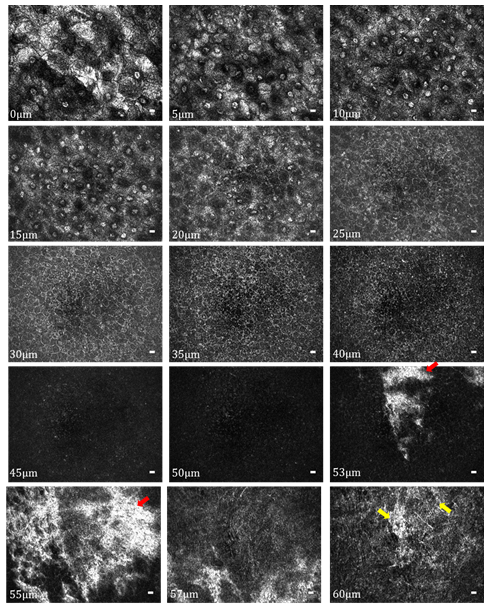
|
|
Fig. 1. FF-OCT en face image sequence of
in vivo
normal rat cornea from the epithelial layer to anterior stroma. The following layers can be identified at the corresponding corneal depths: superficial squamous epithelial layer at 0–20 μm , superficial-to-wing transitional region at around 20 μm , wing layer at 20–40 μm , wing-to-basal transitional region at around 40μm , and basal layer at 40–53 μm . The red arrows mark the interface between BM and epithelium. The yellow arrows mark the anterior stroma. (Scale bar=10 μm ; value within each image corresponds to the depth in relation to corneal surface.) |
|
|
|
|
|
 |
|
 |
|
| |
|
|
 |
|
 |
|
|
|